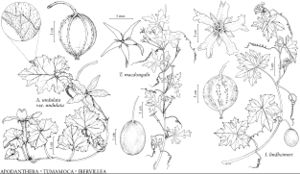Ibervillea
Erythea 3: 75. 1895.
| Taxon | Illustrator ⠉ | |
|---|---|---|
 | Apodanthera undulata var. undulata Tumamoca macdougalii Ibervillea lindheimeri | Yevonn Wilson-Ramsey Yevonn Wilson-Ramsey Yevonn Wilson-Ramsey |
Plants perennial, dioecious, trailing and climbing, often fetid; stems annual or perennial, glabrous [scabridulous]; roots tuberous; tendrils unbranched. Leaves: blade ovate to suborbiculate, broadly ovate, or reniform, usually palmately 5-lobed or pedately 3-lobed, rarely unlobed, lobes narrowly oblong to linear or cuneate to flabellate or rhombic-ovate, margins lobulate or coarsely toothed [denticulate], surfaces eglandular. Inflorescences: staminate flowers solitary or 4–12 (–24) in axillary racemes, racemoid panicles, or corymboid clusters, rarely solitary; pistillate flowers solitary; bracts absent. Flowers: hypanthium narrowly campanulate to cylindric [obtriangular]; sepals 5, broadly deltate to triangular; petals 5, distinct, greenish yellow to yellow, [whitish], narrowly oblong to linear-oblong, clawed, 3–7 mm, apex shallowly 2-lobed, infolded in bud, densely glandular-pubescent adaxially, corolla salverform. Staminate flowers: stamens 3; filaments inserted near hypanthium rim, distinct, nearly vestigial; thecae distinct [weakly connate in I. fusiformis and I. guatemalensis], linear-oblong, without terminal appendage, connective narrow; pistillodes absent. Pistillate flowers: ovary 3 (–5) -locular, ellipsoid to fusiform; ovules 2–35 per locule; style 1, narrowly columnar; stigmas 3, coiled; staminodes absent or present. Fruits berrylike, dark orange to red, globose to ellipsoid, smooth, glabrous, irregularly dehiscent. Seeds (2–) 6–18 [–100], irregularly ovoid, compressed, red-arillate, margins prominent, raised, surface corky-pleated [smooth]. x = 12.
Distribution
sw United States, Mexico, Central America (Guatemala)
Discussion
Species 6 (2 in the flora).
Ibervillea was expanded by D. M. Kearns (1994) to include the monospecific Mexican genus Dieterlea––as Ibervillea fusiformis (E. J. Lott) Kearns. This species had previously been segregated on the basis of its perennial stems, larger, white, nocturnal flowers, connate anthers, four or five placentae, four or five bilobed stigmas, and five staminodia; with incorporation of other species from Mexico and Guatemala, wider variation in Ibervillea includes the features of Dieterlea.
Selected References
None.
Lower Taxa
Key
| 1 | Leaf lobes 10–25 mm wide; petals 5–7 mm; fruits 2–3.5 cm. | Ibervillea lindheimeri |
| 1 | Leaf lobes 2–5 mm wide; petals 3–4 mm; fruits 1–1.5 cm. | Ibervillea tenuisecta |